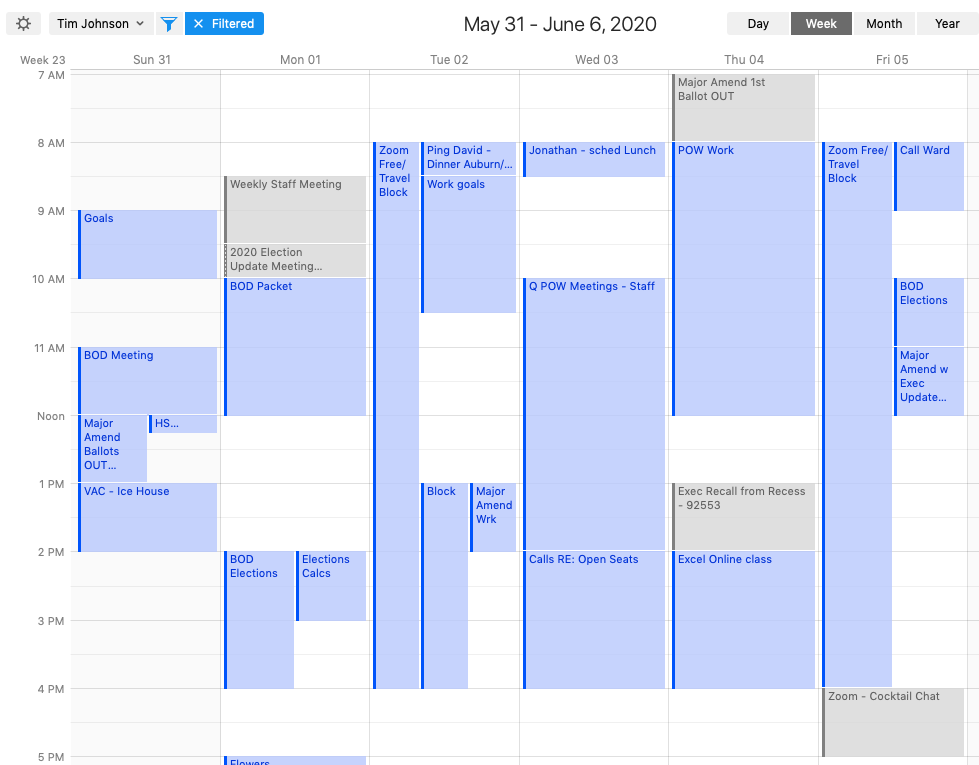Hacks and Tips for Remote Work – Part 1
By Tim Johnson
Implementing a remote office is one of the best management decisions of my career. As I mentioned in my last blog, productivity and job satisfaction are off the charts and there are real improvements to the bottom line, with a more compact office footprint.
So now you have all this time. You are going to be SO productive, not having to commute, travel to meetings and deal with coworker interruptions. Sad news – in reality, you have now become your own biggest obstacle to productivity. In fact, an argument can be made that you always have been, there are just fewer people to blame now!
Here are the tools I’m using to make sure I don’t just sit with the dog and lose track of opportunity gained.

Lots of Planning – Weekly/Monthly/Quarterly/Annual
Author Michael Hyatt is an advocate of creating a clear 1–year plan and practicing the discipline of scheduling specific activities to reach your goals. Then you set up a mechanism for evaluating progress toward achievement. His major theme is that few plan and fewer track progress against goals. Do these two things well and you will be more successful and better able to adapt to the changes that inevitably come up. He is right!
As an outgrowth of this and other reading, I have developed the following practices:
1. Annually I take 2 days to develop professional and personal goals, strategies and supporting tactics. The first day is to decompress. The second is to roll up my sleeves. At this time, I book my vacations for the year and block quarterly planning and monthly planning sessions for the entire year. This planning is offsite and I take vacation to ensure minimal interruptions.
2. Quarterly I take half a day and review macro issues that are impacting me and track them over time. The questions are simple – what are the major economic, political, policy and personal issues impacting work and life the most. I then develop tactics I will employ to achieve my annual objectives and schedule them.
3. Monthly I spend 2 hours looking at my calendar 6 months out and making sure have all major items scheduled and that I have blocked key times for project work or other activities (see timeboxing below).
4. Weekly Every Sunday afternoon I spend about 2 hours wrapping up my week and planning the next two weeks. I start with cleaning up email that needs attention. If the reply is short or I just need to file an attachment, I take care of it immediately. If it needs more attention, I schedule it as a specific activity on my calendar in the upcoming weeks. Second, I clear as many of the documents I have saved to my desktop as possible. Finally, I schedule program work for the next two weeks and review meetings. Monday I am fully ready to roll.

Timeboxing
When I look at my calendar on a monthly basis, looking out a full 6 months, I block no fewer than three 4–hour blocks every week to ensure that I have time for projects, writing and planning activities that are easily overwhelmed by meetings and work scheduled by others. These blocks are my time to work on the specific tasks that are aligned with my annual goals. I also block time for planning, learning, and reading. Since these blocks are assigned during my monthly planning process, I have the things that are most important scheduled out a full six months.
I also block time free of the now ever-present Zoom and other video calls. No one should have a full week of conference calls and Zooms calls just because we are all working remotely!
Weekly, I block time for specific activities that have come up over the previous week – reviews, reading reports and other tasks. Combined with the standing blocks for project work and key standing activities these blocks drive my activities each week.
When the inevitable conflict arises and a meeting needs to be scheduled during a blocked time, I simply move the impacted block to another slot. The meeting gets scheduled and I don’t lose the activity it replaced.






